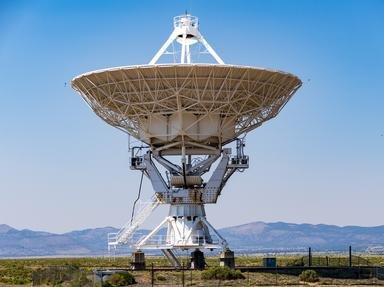Quiz Answer Key and Fun Facts
1. As this is a quiz about cosmological timescales, let's first make sure we know the difference between units of time and those used to measure other things. Which of the following can be used as a measure of time?
2. It all started with the Big Bang, which is predicted to have occurred approximately 13.7 billion years ago, leading to the expansion of the universe. After observing many galaxies, which astronomer proposed a law showing the relationship between the distance from the earth and the velocity at which each galaxy was moving away (recession velocity)?
3. Almost as old as the universe itself is our galaxy, the Milky Way. One of the oldest objects in our galaxy is the star HE 1523-0901, which is estimated to be around 13.2 billion years old, only 0.5 billion less than the age of the universe. What kind of star is HE 1523-0901?
4. The Milky Way galaxy is one of the two most massive galaxies in the so called 'local group', which comprises 54 nearby galaxies. We are approaching the second large galaxy at a rate of around 400,000 km/h but don't worry because it'll take around 3 billion years for the two galaxies to collide. What is the name of the second galaxy?
5. The Solar System in which we live was formed around 4.6 billion years ago when a large molecular cloud collapsed into a disc, eventually producing the planets and other features that we see today. Which of the the following can actually be found within our solar system?
6. Our solar system is found on the Local Spur and takes approximately 250 million years to orbit the centre of the Milky Way galaxy, a length of time known as the Galactic year. Can you tell me what can be found at centre of our galaxy?
7. In astronomy we have the concept of the main sequence. This is the part of a star's lifetime where normal fusion (from Hydrogen to Helium) is occuring in the core and the star can be called stable. A star of a similar mass to the sun will stay on the main sequence for approximately 12 billion years, almost as long as the age of the universe. We can observe the main sequence on a H-R diagram, but can you tell me what this stands for?
8. True or False: The mnemonic 'Oh Be A Fine Girl, Kiss Me' is used to remember the different types of galaxies.
9. After a look at how the vast majority of astronomy takes millions (or billions) of years to develop, let's take a look at a few concepts on a much smaller timescale. We've all heard of Halley's comet, which has a period of around 76 years, but can you tell me why the comet bears this name?
10. Light travels extremely fast, and so within the solar system it can get from one place to another very quickly. For instance it takes only 1 second from the Earth to the Moon and 8 minutes from the sun to the Earth. Can you tell me roughly how long it takes light to travel from the sun to Neptune, the outermost planet of our solar system?
Source: Author
pagea
This quiz was reviewed by FunTrivia editor
WesleyCrusher before going online.
Any errors found in FunTrivia content are routinely corrected through our feedback system.

